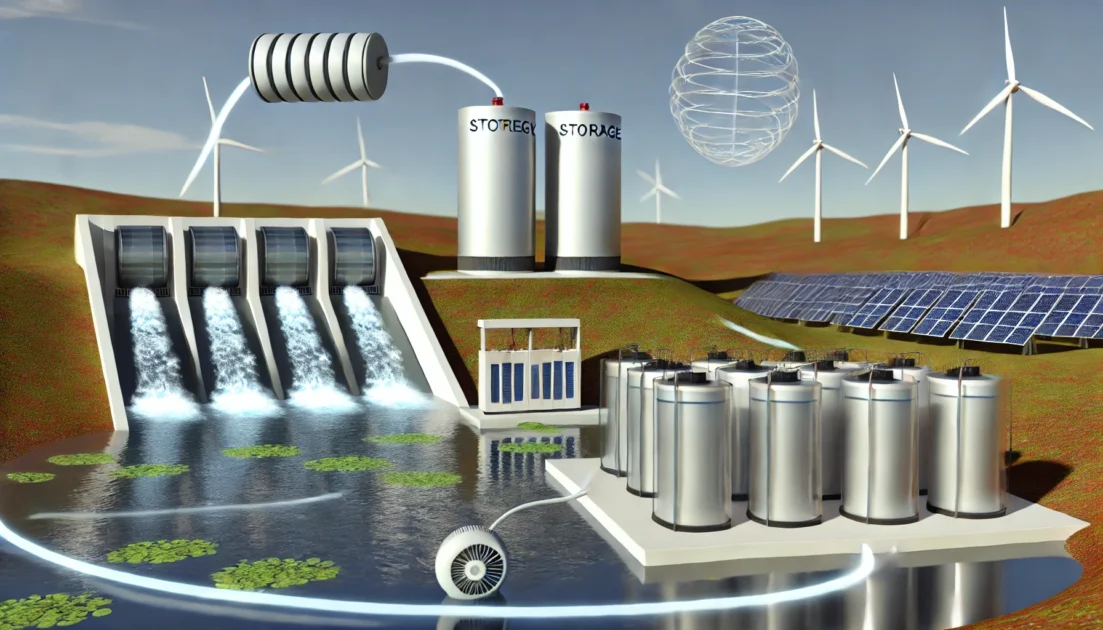4. Energy Storage: Powering the Future of Balance

Imagine a world where energy is always available when needed, regardless of the time of day or the whims of nature. Energy storage is a big part of making that dream a reality. But what exactly is energy storage, and why is it so crucial? Let’s break it down.
Types of Energy Storage
When we talk about energy storage, it is easy to think of batteries first, but there is so much more going on.
- Batteries: These are the most commonly discussed. From the lithium-ion battery in your phone to the huge ones in electric vehicles and large-scale grid applications, batteries store electricity when demand is low and release it when demand is high. Batteries come in many types, including lithium-ion, solid-state, and flow batteries, each with unique advantages. For instance, lithium-ion batteries are lightweight and energy-dense, making them ideal for mobile applications like EVs, while flow batteries are excellent for long-duration grid storage.
- Pumped Hydro Storage: Imagine water being pumped uphill into a reservoir when there is excess electricity available, then released downhill to generate electricity when it is needed. This is the idea behind pumped hydro storage, one of the oldest and most widely used methods. It is particularly good for storing energy on a massive scale over long periods.
- Compressed Air Energy Storage (CAES): This method involves storing air in large underground caverns during periods of low energy demand. When electricity is needed, the air is released and used to power a turbine that generates electricity. It is not as common as batteries or pumped hydro, but it is useful for large-scale applications.
- Thermal Energy Storage: Have you ever thought of storing energy as heat? In thermal energy storage, surplus electricity is used to heat a substance (like molten salt), which can later be used to generate power or provide heat when needed. This method is especially popular with concentrated solar power plants.
- Flywheels: Flywheels store energy by spinning a rotor at very high speeds. When the grid needs electricity, the rotor’s speed slows down, converting the kinetic energy back into electricity. While flywheels are not suited for long-term storage, they are great for providing quick bursts of power to stabilize the grid.
Balancing Supply and Demand
Energy storage plays a crucial role in balancing the grid by ensuring that electricity is available even when production dips. Picture this: solar panels produce power during the day when the sun shines, but what happens at night? Without storage, we would be in the dark. Energy storage absorbs this surplus energy during the day and releases it when the sun is down.
Similarly, wind power is inconsistent—it depends on when and how much the wind blows. Storage systems help bridge those gaps, allowing us to harness more renewable energy without sacrificing reliability.
Beyond Just Balance
But energy storage does more than just balance supply and demand. It is also key to:
- Stabilizing the Grid: Grid stability is about more than having enough energy—it is about keeping the system operating smoothly. Sudden changes in electricity demand or supply can cause frequency imbalances, and energy storage provides quick injections or reductions of electricity to keep the system running steadily.
- Supporting the Growth of Renewables: As the world leans into solar, wind, and other renewables, energy storage allows these intermittent sources to make a greater contribution. Without storage, there is only so much renewable energy the grid can handle without running into reliability issues.
- Reducing Reliance on Fossil Fuels: In traditional grids, when demand peaks, fossil fuel power plants are often brought online to supply extra electricity. Energy storage can reduce the need for these “peaker” plants by discharging stored energy during high-demand periods, ultimately helping to lower emissions.
- Managing Costs: Storage can also play a significant role in cost management. By storing electricity when it is cheap (during off-peak hours) and releasing it when prices are high (during peak demand), both utilities and consumers can save money.
The Future of Energy Storage
The world is getting serious about energy storage, with innovations cropping up everywhere. From massive utility-scale battery installations to experimental technologies like hydrogen energy storage, the race is on to make energy storage cheaper, more efficient, and more widespread.
As technology improves, we will likely see storage solutions that are smaller, more portable, and even more integrated into everyday life. Picture a future where your electric vehicle’s battery not only powers your car but also stores energy for your home. Or where every home has its mini energy storage system, providing power during blackouts or reducing the need for expensive grid upgrades.
